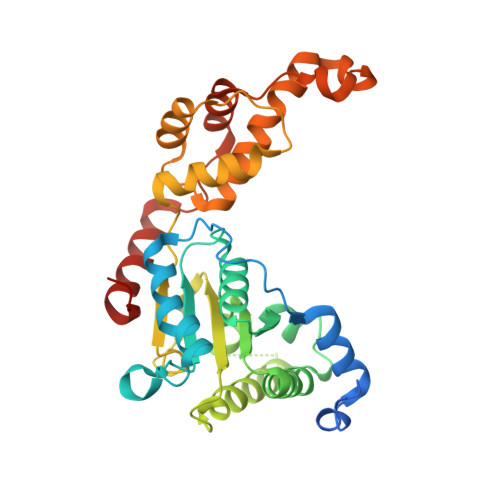Structural insights into the unusually strong ATPase activity of the AAA domain of the Caenorhabditis elegans fidgetin-like 1 (FIGL-1) protein.
Peng, W., Lin, Z., Li, W., Lu, J., Shen, Y., Wang, C.(2013) J Biological Chem 288: 29305-29312
- PubMed: 23979136
- DOI: https://doi.org/10.1074/jbc.M113.502559
- Primary Citation of Related Structures:
4L15, 4L16 - PubMed Abstract:
The FIGL-1 (fidgetin like-1) protein is a homolog of fidgetin, a protein whose mutation leads to multiple developmental defects. The FIGL-1 protein contains an AAA (ATPase associated with various activities) domain and belongs to the AAA superfamily. However, the biological functions and developmental implications of this protein remain unknown. Here, we show that the AAA domain of the Caenorhabditis elegans FIGL-1 protein (CeFIGL-1-AAA), in clear contrast to homologous AAA domains, has an unusually high ATPase activity and forms a hexamer in solution. By determining the crystal structure of CeFIGL-1-AAA, we found that the loop linking helices α9 and α10 folds into the short helix α9a, which has an acidic surface and interacts with a positively charged surface of the neighboring subunit. Disruption of this charge interaction by mutagenesis diminishes both the ATPase activity and oligomerization capacity of the protein. Interestingly, the acidic residues in helix α9a of CeFIGL-1-AAA are not conserved in other homologous AAA domains that have relatively low ATPase activities. These results demonstrate that the sequence of CeFIGL-1-AAA has adapted to establish an intersubunit charge interaction, which contributes to its strong oligomerization and ATPase activity. These unique properties of CeFIGL-1-AAA distinguish it from other homologous proteins, suggesting that CeFIGL-1 may have a distinct biological function.
- From the Institute of Protein Research, Tongji University, Shanghai 200092 and.
Organizational Affiliation:

















